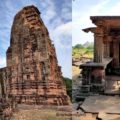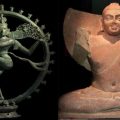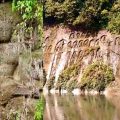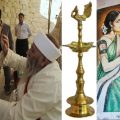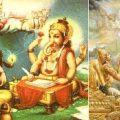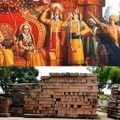When Gods Wake Up: What the Movie Kantara Means for Hindus
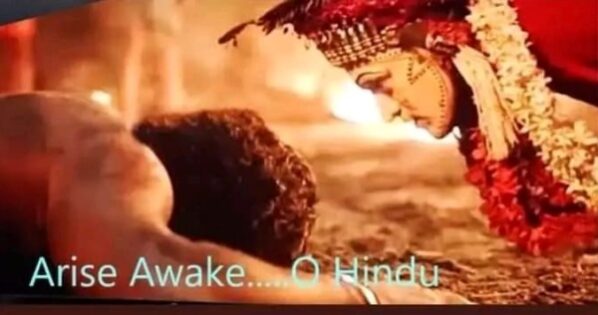
Raw! Visceral! Existential! Unprecedented! And flagrantly Hindu! That is what Kantara is, and oh how! It is a celebration of ‘Being Hindu’. It is a movie made by the Deva himself. This is how Kantara completely inverts the way the colonized Hindus have been interpreting their own world, culture and civilization to the world in the past 200 years and inverts it to bring it back to its original position – fearless, unconscious recognition of the Divine all around us!
It is not a story told by humans about the Devas. It is a story which the Deva tells to humans, from a divine point of view. Since our contact with the West, Hindus have been trying to ‘interpret’ their dharma, rituals, customs & tradition in the language of the colonizers.
We have become accustomed to say, ‘it is a Hindu ‘belief’…’, ‘according to Hindu beliefs…’ almost completely convinced ourselves that our stories are just fairy tales imagined by illiterate, superstitious and ignorant ancestors, which need ‘scientific interpretation’. Slowly, we became so used to this constant cultural translation in our minds that we ourselves started believing that our stories are just stories with no existence on any plane of consciousness. We became ‘rational’ and bought into the Judeo-Christian/ Enlightenment paradigm.
Kantara inverts that and removes this layer of self-interpretation and cultural translation. There is no attempt to ‘interpret’ our rituals like Bhooth Kola to the world. There is no attempt to add a disclaimer of ‘belief’ when the Deva descends into the Kola dancer.
Wade Davis, perhaps the greatest cultural anthropologist ever born, describes a scene about a shaman ritual of a Colombian Amazonian tribe in which the shaman takes psychedelic compounds to reach higher planes of consciousness. Davis says: “The shaman doesn’t BELIEVE that he becomes the Jaguar. He ACTUALLY BECOMES the jaguar.” He showcases the very fault in our language, in our ways of thinking and expressing.
The Devas are not ‘beliefs’. They are not mere stories. They exist. On a more primal and fundamental level than us. They exist on planes of consciousness which we have to access by constant sadhana, shraddha and ritual lifestyle. This is what Kantara movie teaches us. The first & greatest achievement of Kantara is that instead of portraying reality as seen by Hindus as ‘beliefs’, it portrays it as reality. Just as it should be. Hindu dharma is not a belief system. Hindu Devas are not concepts or stories. They exist. Kantara shows that.
Kantara doesn’t just show Devas and Hindus as they should be. It manages to showcase the regional beauty of Kanara in its most passionate and resplendent form. For that a little background is needed. Spoiler alert though I won’t talk at all about the climax or plot secrets. The movie is about a tribe living on a sacred ancient forest in coastal Kanara. In visual symbolism, in artistic props, in storyline, language, metaphors, music, art, casting and cultural artefacts the movie is quintessentially Kanara/ Tulu. As it should be. We have become used to watch completely and horribly copied plots, stories, concepts and even acting in Bollywood with Laal Singh Chaddha being the latest example. They have no connection to the native Hindu reality. No wonder their time is up.
Kantara uses every local symbolism in this movie. You see Kambala race as it should be, full of mud, water buffaloes, and bare-bodied men racing them. The landscape is very authentic. The hero and others are not the chiseled men of tinsel towns. Rishabh Shetty shines in his uncouth appearance, not just through his acting but also through his acting completely local. I was gladdened to see the Panchalingeshvara temple at Barkur, near Udupi in one shot. It is a temple which has grown close to my heart. Local place names like Kundapura are repeated again and again and are part of the background talks of the characters. As I have frequented this region scouring its temples, this was an additional gift to me and would be to anyone who comes from that region. The areca nut flowers that are offered to deities in this belt are shown everywhere: in the temple, on the Kola dancer, near the sacred torch which is transferred by the god to the hero.
The central ritual on which the movie rests is Bhootha Kola ritual dance, somewhat similar to Theyyam of nearby Kerala. Bhooth Kola ritual is very vividly authentically done and is consciousness raising. It is impossible to not feel your spine erect, hairs raise, attention becoming ekagra with bhakti when the ritual plays on screen. It makes your inner Hindu springs out and stand in bhakti instantly. Something unprecedented in the history of Indian cinema.
This is the second point that Kantara delivers. It gives a master class in how a movie about Bhāratavarṣa should be made. It has to use regional symbols to deliver a quintessentially Hindu/ Bharatiya story. It shows how the Desiya and Margiya come together in story-telling. If the props are not regional and local, then the story won’t be authentic. If it does not signal to the universal Hindu element then it won’t be meaningful outside that region. More on Margiya-Desiya later.
The movie starts with an exemplary Hindu king of coastal Kanara having everything in life, and yet having ‘divine dissatisfaction’ in Shri Ram Swarup’s words. As Ramachandra Ji says, it is a quintessentially Hindu thing to have everything in life and yet yearn for the divine. He goes to the forest and stumbles upon a ‘rock’ who is the Deva Panjurli of a forest tribe. He feels fulfilled just in the presence of the deity and instantly gives up his arms, signaling the submission of the kshatriya in front of a Deva. He wants the deity to come with him. The deity then speaks through his oracle and says that he has to give land to the point his voice reaches (100 acres) to the villagers and if he, his descendants, or anyone tries to take it then there will be fearful consequences. If not Panjurli, then his companion Guliga will punish the perpetrator for he never lets wrongdoers go. He is a fiercer companion of an already fierce god. And here is where Kantara doesn’t waste anytime in displaying Hindu gods as they should be.
This scene sets the tone of the movie. That the Hindu gods displayed in the movie won’t be like soft, cute gods of the neo-Vedantin variety. The gods here are primal, fearsome and terrifying in their aspects. The Hindu gods are terrifying beautiful. Kantara shows that.
Almost two decades ago, when I was initiated by my guru into sadhana, the first warning that he gave to me was this: you are sure to encounter our gods on your journey. But be warned. They are seldom the gentle beings that are displayed in Raja Ravi Verma calendars. He said that they are often so terrifyingly fierce and indescribably overwhelming in their appearance and feeling that anyone who first encounters them is sure to be aghast. So be warned. And he said this not about any regional gods. Even gods like Hanuman, Vishnu and Saraswati whom we know for their softer aspects too, are terrifyingly fierce in their real appearance. I am not at a liberty to reveal what happened later, but let us just say he had so so so rightly warned me.
Kantara shows our gods as they really are. This cannot come from ‘study’ or ‘rigor’ or ‘discipline’. It comes from a direct experience of the divine. And the divine has touched Rishabh Shetty and the crew of the movie in all the right manners.
The Bhootha Kola ritual has another great significance. The very term Bhootha has now been rendered as a translation of ‘ghost’. We can’t be more wrong if think so. Bhoothas do exist amongst us. And they give, as they take. They take vessels and communicate to us. The Bhootha Kola ritual in the movie conveys that perfectly and with 100% accuracy.
I remember almost 20 years ago when I first talked to my friend who had just shifted to the city from a village in Morena. He represented a world I was scarcely aware of. Once he was talking about ‘Devas’ and ‘Bhoothas’ along with his relatives, as if these divine beings were almost their family members. He would say that “when my brother went to sleep the Deva came and woke him up…” My rational training resisted. I said that the divine might exist and be achieved high in states of meditation but to ‘talk to devas and bhoothas’ like they live with you in your village must surely be bullshit, or psychological disease. It was then that my friend said something I can never forget. He said that “if you don’t believe in the Bhoothas then you also don’t believe in Bhagawana (deities or god), for they both exist on the same plane.” If I don’t accept the existence of Bhoothas then I am an atheist. It took me a decade to realize the depth of what he spoke.
That the neo-Vedantin lofty talk that I had become used to was just another Christian ploy to de-sacralize Hindu dharma and its cultural ethos. They had separated our darshana from our rituals: accepting ‘high philosophy’ and rejecting ‘low superstition’. And I, like millions of other ‘rationally-educated Hindus’, had come to accept it lock stock and barrel. I did not understand that by making dharma disappear from daily Hindu life, I was helping my society to Christianize later.
For it is not the texts and the scholars who study them who save dharma. It is the practicing Hindu who goes through Hindu rituals and customs who save dharma. Hindu dharma is a ritual. Hindu dharma is practice. Without sadhana, rituals, customs and traditions, darshana is mere philosophy, useless, impotent and incapable of sustaining and generating a dharmic society. And Kantara once again shows that it is the ritual which is important.
The movie also demolishes the ‘rational-atheist-scientific’ point of view very well. The forest officer who wants to create a reserved forest buys into the ‘rational-logical’ point of view that is the point of view of a constitutional State like India. He comes in clash with the ‘beliefs’ of the villagers, but is shocked to know that for them they are not beliefs. He insults the Deva, which angers the hero and everyone else. He tries to prevent them from taking stuff for Kola ritual and meets with great resistance and loses.
But the highlight is when he tries to stop the Hindus from celebrating Kola by preventing them from bursting firecrackers. (also handling the ‘dogs will be hurt on Diwali’ brigade). The hero dismisses the ‘animals are inconvenienced’ argument. The hero tries to instigate the forest officer to file a case in court, mocking him. The officer then asks a question which any rationalist judge, or a state officer in India would ask. “Who will represent you in court, your Deva?” Mockingly implying that Deva doesn’t exist.
His mockery is brushed aside by villagers and the hero who has no doubt that the Deva exists. What better way to support the case of Lord Ayappa of Sabarimala! And at last the officer becomes a believer and witnesses the coming of Deva Guliga on Śiva. The opening Bhootha Kola ritual sequence addresses this ‘rationalist atheism’ of modern Hindus. Hindus who think that gods are mere concepts mockingly asks whether it is the ‘dancer’ or the Deva speaking? The Deva then runs in the forest and disappears, answering him.
Even the way the Deva punishes is very Desiya. The scion of the king who asks for his land back dies on the steps of the court vomiting blood. This is exactly how the god Koragajja of the Mangalore region punished the peacefuls who put condoms in its Hundis. Kantara shows that there are all kinds of gods and Hindus know that intuitively. And most of them are not just capable of gently giving them jnana, but also capable of fiercely punishing the wrongdoers. That they are capable of punishing melchhas.
Kantara is known for its local gods and goddesses, kshetrapalakas, grama devatas, kula devatas, who are often represented by their accoutrements like their headgear. Kantara shows this symbolism all throughout the movie: the dress, the anklet, the headgear, the torch. And these gods of Kanara and neighboring Kerala are generally fierce. You can appease them easily and they will give you what you want, but you also have to give them what they want. Any failure, advertent or inadvertent results in serious punishments. It is the character of these Desiya gods, and more or less the entire Bhāratavarṣa has them. The presence of these Desiya gods is even more immediate and palpable than what we are generally accustomed to. Himachal and other tribal areas have similar gods.
But this does not mean that these gods are at loggerheads with the Margiya tradition. And what is the most amazing amazing thing about the Kantara movie is that it not only understands the Desiya and Margiya tradition but also shows their interrelation perfectly. Fierceness is not something exclusive to the regional gods. Vishnu is the most popular of all deities and most loved by everyone, women, children alike. And yet has some of the fiercest, primal, raw and wild avataras like Lord Narasimha and Lord Varaha.
And it is on the Varaha avatara that the movie Kantara hinges. The symbolism of the wild boar haunts the movie throughout. It is no less than Varaha Swamy, the great Vishnu in his boar form who guides the hero in all his crucial moments, leading to the finale. The last Bhootha Kola ritual is such an amazing coming together of the Desiya and Margiya tradition and gods. While the performer, the Bhootha Kola dancer is a vessel of the kshetrapalaka god Panjurli, in the last ritual sequence he is very palpably vessel of Lord Varaha. What is more quintessentially Hindu and Margiya than an incarnation of the great Vishnu himself? And yet all the setting, background and cultural markers are extremely local and regional – Desiya.
As this regional imagery plays down, the strotam that plays in the background is ‘Varaha Roopam Daiva Varishtam…’ in – wait for it – Sanskrit. While god Panjurli always speaks in regional language (Tulu?), the Varaha Strotam plays in Sanskrit. The Bhootha Kola performer (Śiva, the hero), wears a traditional Kanara mask, but the mask is that of a boar, once again showing where the Margiya and Desiya come together. All the Desiya elements come together and feed right into the Marga of Lord Varaha. Is there a better representation of how the Margiya and the Desiya in Sanātana dharma are complementary to each other? That it is not just the regional gods who are fierce. Someone as quintessentially margiya as Lord Varaha can be as or more fierce.
Kantara so amazingly shows how the Margiya, Sanskrit and Hindu tradition complements the Desiya, Prakrut and local tradition. With movie it has decimated all anti-Hindu shenanigans and created so many Hindu pillars.
And at last, the Varaha roopam himself invites the skeptics and believers alike to touch him where his heart is… to show them… the spandana of the universe…
Can there be anything more Hindu? I don’t think so.
No human can imagine this. Deva himself has made this movie. Varaha avatar, ferocious and apt for decimating the mlechha opponents of Sanātana dharma has decided to interfere more deeply with human affairs. And he is perfect for this age, when Hindus are surrounded by enemies from outside and inside. It needs a fierce form like Varaha to wake us up.
The gods have woken up. And Kantara is their way of waking the sleeping Hindus up.
Mlechhas be wary.
The above write-up is by Pankaj Saxena (sourced from his Facebook page). Pankaj Saxena is an author writing on art, aesthetics, history, Hindu architecture and literature, currently working as Ass. Professor at Rashtram School of Public Leadership. He is also the Director of Indic Academy-Rashtram Center for Cultural Leadership.
Facebook Comments Box
The following two tabs change content below.


Team MyIndiaMyglory
Latest posts by Team MyIndiaMyglory (see all)
- BAIC Exhibition: Confluence of Interiors, Architecture, and Construction Industry - October 23, 2024
- Temple Treasures: Evolution of Temples from Ancient to Present - October 23, 2024
- Akal Bodhan: Ram’s Invocation of Durga during War against Ravan - October 23, 2024

